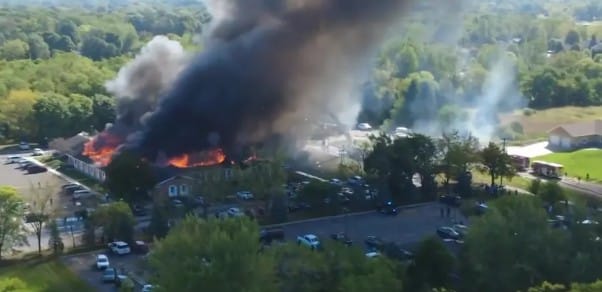Grand Blanc, Michigan — What began as a peaceful Sunday service at a Mormon church erupted into chaos as 40-year-old Thomas Jacob Sanford rammed his vehicle into the building, opened fire with an assault rifle, and deliberately set the house of worship ablaze. By the time the smoke cleared, three people lay dead — including Sanford himself — and eight others were injured, one critically.
President Trump condemned the incident as a “horrendous” attack, pointing to what he called “another targeted assault on Christians in America.” But beneath the political soundbites, a darker truth is emerging — one that links rising social unrest, America’s gun obsession, and even the climate crisis into a web of disconnection and despair.
Sanctuaries Turned Battlegrounds
The Church of Jesus Christ of Latter-day Saints in Grand Blanc, a serene Michigan township of under 50,000 residents, was meant to be a sanctuary — a space of peace, prayer, and community. Yet, it became the latest victim of a growing epidemic: mass violence in sacred spaces.
While Sanford’s motive remains unclear, the symbolism is chilling. The attack came just one day after the death of 101-year-old Mormon Church President Russell M. Nelson — a spiritual giant revered for his messages of peace and moral clarity. For many, the timing felt like a national soul wound ripped open.
America’s Endless Echo Chamber of Violence
This isn’t an isolated incident. From Charleston to Pittsburgh, Sutherland Springs to now Grand Blanc, America’s churches have increasingly become targets. More than 600 mass shootings have occurred annually in recent years — a reality so routine that breaking news banners now feel like background noise.
Critics argue that the root lies in a uniquely American cocktail: a saturated gun market, underfunded mental health systems, and a toxic culture of hyper-individualism. Despite repeated calls for reform, legislation remains stalled — gridlocked by political infighting and gun lobby pressure.
And as Sanford’s actions show, even small-town America is not immune.
The Climate of Violence — Literally and Figuratively
At first glance, climate change may seem irrelevant here. But experts warn that rising social aggression and mental health breakdowns are being subtly shaped by our warming world. A 2022 study in Nature Climate Change found that higher temperatures correlate with increased aggression and violence, particularly in economically strained areas.
Michigan — already grappling with water contamination scandals, agricultural instability, and climate-induced heatwaves — is one of the states at the frontline of environmental anxiety. And as ecosystems unravel, so too does the fabric of community resilience.
Climate grief, isolation, and economic stressors can all amplify mental health crises. When combined with guns and extremist echo chambers, the result is a ticking time bomb.
What Now?
While the FBI leads the investigation, locals are left searching for answers, grappling with trauma, and asking: Why here? Why now? As America mourns, this tragedy underscores a stark truth — violence isn’t just a policy failure. It’s a mirror.
A mirror reflecting our spiritual erosion, political paralysis, and climate despair. To stop the bleeding, we need more than thoughts and prayers. We need action. That includes mental health investment, gun reform, and yes — climate justice.
Because the storms outside are no longer separate from the fires within.




